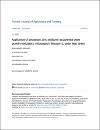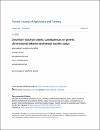تصفح Research of Agricultural Research Station حسب تاريخ النشر
السجلات المعروضة 1 -- 20 من 72
-
Effect of Plant Growth Regulators on Callus Induction from Leaf and Petiole explants of Hummeid (Rumex Vesicarius)
( Qatar University Press , 2021 , Poster)Advancement in plant cell culture technology has permitted the increasing interest in harvesting plant metabolites from cell cultures. This technique is based on in vitro propagation of plant callus which contains many ... -
Detecting Organic Nitrogen with 1H-15N HMBC Spectra
( Qatar University Press , 2021 , Poster)NMR spectroscopy has been the most important tool for organic chemistry research, providing detailed structure information. While 1H and 13C NMR spectra were frequently measured, 15N NMR spectra were relatively rare, even ... -
Ecological and Health Risks Assessment of Potentially Toxic Metals and Metalloids Contaminants
( Qatar University Press , 2021 , Poster)Potentially toxic environmental contaminants, including metals and metalloids, are commonly found in emerging economies. At high concentrations, elements such as As, Cr, and Ni can be hazardous and may lead to various ... -
Spectrophotometric Determination of the Honey Bee Quality
( Qatar University Press , 2021 , Poster)Honey produced by bees from nectar in flowers and plants, is an aqueous supersaturated sugar solution, mainly monosaccharide (fructose and glucose) (70%–80%) and water (10%–20%). 5-Hydroxymethylfurfural (5-HMF) content in ... -
Ecological and Health Risks Assessment of Potentially Toxic Metals and Metalloids Contaminants: A Case Study of Agricultural Soils in Qatar.
( MDPI , 2021 , Article)In recent years, Qatar has witnessed exponential growth in the human population, urbanization, and increased anthropogenic activities, including agriculture. Potentially toxic environmental contaminants, including metals ... -
The Carcinogenic and Non-Carcinogenic Health Risks of Metal(oid)s Bioaccumulation in Leafy Vegetables: A Consumption Advisory
( Frontiers Media , 2021 , Article)High levels of metal(oid)s in soil or food pose a severe health risk to humans. The potential toxicants find their way into the living systems via the food chain, following bioaccumulation in edible plants, including leafy ... -
Principles and Applicability of Integrated Remediation Strategies for Heavy Metal Removal/Recovery from Contaminated Environments
( Springer , 2022 , Article)Contamination of agricultural soils with heavy metals present lethal consequences in terms of diverse ecological and environmental problems that entail entry of metal in food chain, soil deterioration, plant growth ... -
Application of potassium, zinc and boron as potential plant growth modulators in Gossypium hirsutum L. under heat stress
( the Scientific and Technological Research Council of Turkey (TUBITAK) , 2022 , Article)High temperature stress at reproductive stages of cotton crop severely affects the yield and quality of cotton crop under changing climatic conditions. To alleviate the adverse effects of high temperature stress on cotton ... -
Chromium toxicity in plants: consequences on growth, chromosomal behavior and mineral nutrient status
( the Scientific and Technological Research Council of Turkey (TUBITAK) , 2022 , Article)Chromium (Cr) is a heavy metal of commercial importance; thus, significant amounts are released in wastewaters. The mobility and distribution of metals in the environment is related not only to their concentration but also ... -
Individual and Synergic Effects of Phosphorus and Gibberellic Acid on Organic Acids Exudation Pattern, Ultra-Structure of Chloroplast and Stress Response Gene Expression in Cu-Stressed Jute (Corchorus Capsularis L.)
( Springer , 2022 , Article)Copper (Cu) pollution in agricultural soils is considered as a serious health risk due to its accumulation in plants. Thus, there is an urgent need to optimize nutrient application for higher yield with lower Cu uptake to ... -
Silicon Enhances Morpho–Physio–Biochemical Responses in Arsenic Stressed Spinach (Spinacia oleracea L.) by Minimizing Its Uptake
( Springer , 2022 , Article)Soil contamination with toxic heavy metals [such as arsenic (As)] is becoming a serious global problem due to rapid development of social economy. Silicon (Si), being an important fertilizer element, has been found effective ... -
An overview of heavy metals toxicity in plants, tolerance mechanism, and alleviation through lysine-chelation with micro-nutrients—A novel approach
( Springer , 2022 , Article Review)Abstract: Plants must adapt themselves to the prevailing conditions for their survival, resulting in the acquisition of a wide range of metal tolerance mechanisms. Although many metal elements are essential for the growth ... -
S‐Fertilizer (Elemental Sulfur) Improves the Phytoextraction of Cadmium through Solanum nigrum L.
( MDPI , 2022 , Article)Soil contamination with toxic heavy metals [such as cadmium (Cd)] is becoming a serious global problem due to the rapid development of the social economy. This study was carried out to assess the beneficial role of two ... -
Antifungal activity of Zinc nitrate derived nano Zno fungicide synthesized from Trachyspermum ammi to control fruit rot disease of grapefruit
( Elsevier , 2022 , Article)Grapefruit (Citrus paradisi) is a widely grown citrus and its fruit is affected by a variety of biotic and abiotic stress. Keeping in view the hazardous effects of synthetic fungicides, the recent trend is shifting towards ... -
Zinc Oxide Nanoparticles and Their Biosynthesis: Overview
( MDPI , 2022 , Article Review)Zinc (Zn) is plant micronutrient, which is involved in many physiological functions, and an inadequate supply will reduce crop yields. Its deficiency is the widest spread micronutrient deficiency problem; almost all crops ... -
Understanding the Phytoremediation Mechanisms of Potentially Toxic Elements: A Proteomic Overview of Recent Advances
( Frontiers Media , 2022 , Article Review)Potentially toxic elements (PTEs) such as cadmium (Cd), lead (Pb), chromium (Cr), and arsenic (As), polluting the environment, pose a significant risk and cause a wide array of adverse changes in plant physiology. Above ... -
Nickel Toxicity Interferes with NO3−/NH4+ Uptake and Nitrogen Metabolic Enzyme Activity in Rice (Oryza sativa L.)
( MDPI , 2022 , Article)The excessive use of nickel (Ni) in manufacturing and various industries has made Ni a serious pollutant in the past few decades. As a micronutrient, Ni is crucial for plant growth at low concentrations, but at higher ... -
Advances, limitations, and prospects of biosensing technology for detecting phytopathogenic bacteria
( Elsevier , 2022 , Article)Phytopathogenic bacteria cause severe economic losses in agricultural production worldwide. The spread rates, severity, and emerging plant bacterial diseases have become serious threat to the sustainability of food sources ... -
Response of cauliflower (Brassica oleracea L.) to nitric oxide application under cadmium stress
( Elsevier , 2022 , Article)Soil contamination with cadmium (Cd) is a persistent threat to crop production worldwide. The present study examined the putative roles of nitric oxide (NO) in improving Cd-tolerance in cauliflower (Brassica oleracea L.). ... -
Efficient shoot regeneration of medicinal plant Haplophyllum tuberculatum by direct and indirect organogenesis and genetic fidelity assessment using Inter Simple Sequence Repeats markers
( Frontiers in Plant Science , 2022 , Article)In vitro plant cell and tissue cultures are potent tools to propagating germplasm resources in conserving and managing plant genetic resources. A reliable micropropagation protocol was developed for efficient callus ...


















